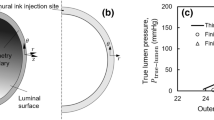Abstract
Based on the patient-specific model of a Type B aortic dissection we created a second model with reduced entry and exit tear size. Two sets of simulations were performed for each model: (i) fluid structure interaction (FSI) and (ii) rigid wall simulations. In both simulation modalities we found that alterations in tear size had substantial impact on true to false lumen flow ratios, true and false lumen pressure differences, and loss of systolic pressure along the dissection. Compared to rigid wall simulations, FSI simulations yielded decreased true lumen flow ratios, increased dampening of flow waveforms along the aorta, smaller negative pressure differences in the distal dissection, and smaller systolic pressure drops across entry and exit tears. These results underline the sensitivity of simulation-based quantitative hemodynamics in aortic dissections to tear size and tissue stiffness.
Access this chapter
Tax calculation will be finalised at checkout
Purchases are for personal use only
Similar content being viewed by others
References
Erbel, R., et al.: 2014 ESC guidelines on the diagnosis and treatment of aortic diseases. Eur. Heart J. 35(41), 2873–2926 (2014). https://doi.org/10.1093/eurheartj/ehu281
Yuan, X., et al.: Conservative management versus endovascular or open surgery in the spectrum of type B aortic dissection. J. Visualized Surg. 4, 59 (2018). https://doi.org/10.21037/jovs.2018.02.15
Zilber, Z.A., et al.: Noninvasive morphologic and hemodynamic evaluation of type b aortic dissection: state of the art and future perspectives. Radiol. Cardiothorac. Imaging 3(3) (2021). https://doi.org/10.1148/ryct.2021200456
Chen, H.Y., et al.: Editor’s choice - fluid-structure interaction simulations of aortic dissection with bench validation. Eur. J. Vasc. Endovasc. Surg. 52(5), 589–595 (2016)
Burris, N.S., et al.: Retrograde flow in the false lumen: marker of a false lumen under stress ? J. Thorac. Cardiovasc. Surg., 1–5 (2018). ISSN 0022–5223. https://doi.org/10.1016/j.jtcvs.2018.06.092
Huanming, X., et al.: Computed tomography-based hemodynamic index for aortic dissection. J. Thorac. Cardiovasc. Surg. 162, e165–e176 (2020)
Bäumler, K., et al.: Fluid–structure interaction simulations of patient-specific aortic dissection. Biomech. Model. Mechanobiol. 19(5), 1607–1628 (2020). https://doi.org/10.1007/s10237-020-01294-8
Si, H.: Adaptive tetrahedral mesh generation by constrained Delaunay renement. Int. J. Numer. Methods Eng. 75, 856–880 (2008). ISSN: 00295981. eprint: 1010.1724. https://doi.org/10.1002/nme.2318
Updegrove, A., Wilson, N.M., Merkow, J., Lan, H., Marsden, A.L., Shadden, S.C.: SimVascular: an open source pipeline for cardiovascular simulation. Ann. Biomed. Eng. 45(3), 525–541 (2016). https://doi.org/10.1007/s10439-016-1762-8
Ennis, D.B., Perotti, L.E., Wang, V.Y. (eds.): FIMH 2021. LNCS, vol. 12738. Springer, Cham (2021). https://doi.org/10.1007/978-3-030-78710-3
Vignon-Clementel, I.E., Alberto Figueroa, C., Jansen, K.E., Taylor, C.A.: Outflow boundary conditions for three-dimensional finite element modeling of blood flow and pressure in arteries. Comput. Methods Appl. Mech. Eng. 195(29–32), 3776–3796 (2006). https://doi.org/10.1016/j.cma.2005.04.014
Esmaily-Moghadam, M., Bazilevs, Y., Marsden, A.L.: A bipartitioned iterative algorithm for solving linear systems arising from incompressible ow problems. Comput. Methods Appl. Mech. Eng. 286, 40–62 (2015). https://doi.org/10.1016/j.cma.2014.11.033
Acknowledgment
This work used the Stanford Research Computing Center (SRCC). Additionally, we acknowledge the open-source projects Paraview at www.paraview.org, Meshmixer at www.meshmixer.com, itk-SNAP at www.itksnap.org, and the open-source SimVascular project at www.simvascular.org.
Author information
Authors and Affiliations
Corresponding author
Editor information
Editors and Affiliations
Rights and permissions
Copyright information
© 2023 The Author(s), under exclusive license to Springer Nature Switzerland AG
About this paper
Cite this paper
Bäumler, K., Zimmermann, J., Ennis, D.B., Marsden, A.L., Fleischmann, D. (2023). Hemodynamic Effects of Entry Versus Exit Tear Size and Tissue Stiffness in Simulations of Aortic Dissection. In: Tavares, J.M.R.S., Bourauel, C., Geris, L., Vander Slote, J. (eds) Computer Methods, Imaging and Visualization in Biomechanics and Biomedical Engineering II. CMBBE 2021. Lecture Notes in Computational Vision and Biomechanics, vol 38. Springer, Cham. https://doi.org/10.1007/978-3-031-10015-4_13
Download citation
DOI: https://doi.org/10.1007/978-3-031-10015-4_13
Published:
Publisher Name: Springer, Cham
Print ISBN: 978-3-031-10014-7
Online ISBN: 978-3-031-10015-4
eBook Packages: EngineeringEngineering (R0)




